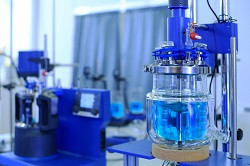New techniques aim to energise EU chemical industry
The EU-funded MAPSYN project has successfully developed industrial-scale micro-reactors and continuous flow reactors that efficiently allow assisted chemical synthesis by unconventional energy sources. Exploitable results include flow modules ready for commercialisation, patented catalysts and new chemical production techniques. These innovations could help to reduce production costs for Europe’s chemical industry and increase yields through continuous rather than batch processing. ‘There has already been a great deal of work in this field, driven by the need to achieve greater energy efficiency in the production of useful chemicals, speedier processing and higher yields,’ says project Manager Dr Rachel James from C-Tech Innovation in the UK. ‘The MAPSYN project brought together new, innovative energy efficient chemical reaction processes and catalysts, and scale these up to the manufacturing level while keeping cost and energy requirements as low as possible.’ Europe’s chemical industry produces 16.7 % of the world’s chemicals, employs 1.2 million workers and contributes € 527 billion to the EU economy. It is the world’s top exporter and importer of chemicals, supplies virtually all sectors and provides key products and services to industries ranging from pharmaceuticals, cosmetics and health to construction and agriculture. Global competition is fiercer than ever, especially from regions of the world that often have easier access to raw materials and a cheaper supply of energy and labour. It is vital therefore that Europe develops production efficiencies and sustainable solutions that maintain its global position and contribute towards EU environmental goals. A key element of the MAPSYN project was the construction of two demonstrators, which enabled the team to collect data on energy efficiency and yield. The first demonstrator tested a plasma-assisted nitrogen fixation process that showed promising yield and energy usage. In the second, micro-reactors designed to be transparent to microwave radiation were developed and combined with novel catalysts and an innovative microwave flow system. ‘We are just about to start the final round of testing and are confident that this will demonstrate clear benefits of the technology,’ says James. Indeed, both demonstrators have shown the viability of using plasma and microwaves as innovative energy sources in order to achieve necessary chemical reactions. Flow process modules developed by project partners have already been commercialised. In addition, project partners successfully synthesised and characterised new catalysts for nitrogen fixation and hydrogenation, which the team are confident will offer higher yield. Some of the hydrogenation catalysts have since been patented. ‘If both demonstrators achieve good final results, then it is likely that our industrial partners will continue to run tests following completion of this project, in order to obtain as much data as possible,’ says James. ‘The key questions are whether the new systems offer cost efficiencies to end users, whether the newly developed catalysts can be used on their own, and also whether the new microwave systems might have other applications.’ The technologies have the potential to open doors to new business models and possible new products. The project has therefore been a success from an exploitation point of view. ‘Some catalysts have been patented, while our analysis of others has helped us to better understand their properties,’ explains James. ‘We’ve also taken the plasma process from small laboratory scale to manufacturing level. So there has been a lot of useful early stage research carried out as well as the development of potential new industrial applications.’ The MAPSYN project is due for final completion at the end of May 2016.
Keywords
MAPSYN, new energy sources, catalysts, micro-reactors, energy efficiency, demonstrators, plasma process



